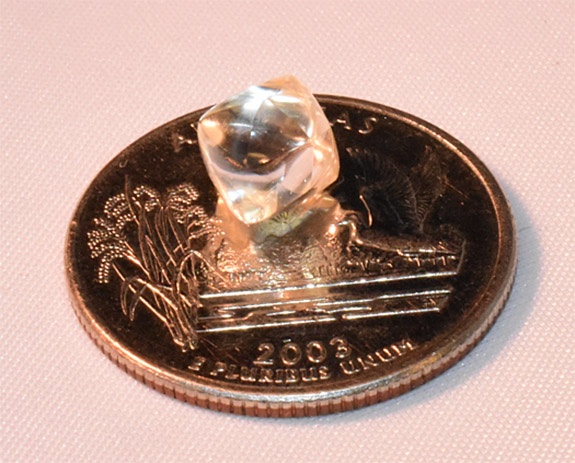
Music Friday: Country Star Don Williams Shines With ‘Gold in the Morning Sun’
Welcome to Music Friday, when we spotlight classic songs that sparkle with references to jewelry, gemstones or precious metals. Today, we turn back the clock
Have you ever marveled at the lustrous mother-of-pearl coating on the interior shell of an oyster or abalone? The Nautilus pompilius, commonly known as the “pearly nautilus,” also has an iridescent, silvery interior shell — a shell so extraordinary that Indonesian island communities were cherishing it during the late Ice Age.

Australian and Indonesian researchers discovered hundreds of carefully crafted Nautilus shell beads in a Makpan Cave on the Indonesian island of Alor, one in a string of islands that run West to East just north of Australia. The carved and drilled reflective beads were fabricated 12,000 years ago and were likely sewn like sequins onto clothing. The beads averaged about a quarter inch across, but some were nearly a half-inch wide.

What’s more, the pearly fashion statements — most with two drill holes — match up with similar findings on the neighboring Indonesian islands of Timor and Kisar, proving that the populations participated in a maritime network and shared traditions. The scientists discovered that the nacreous surface of several beads had been deliberately scratched with a stone tool edge, possibly to increase their reflectivity.

The team, led by Griffith University’s Associate Professor Michelle Langley and the Australian National University’s Professor Sue O’Connor, used advanced microscopic analysis to investigate the Nautilus shell beads. The team explained on the Griffith University website that recent DNA evidence has shown how people on different Indonesian islands were genetically related, but the shell beads are now putting into focus how culturally similar the populations were.
“The time and skill required to create the tiny shiny beads in the numbers found archaeologically must have been extensive, suggesting that the beads were an important part of the Makpan community’s repertoire of adornment,” said Langley, the study’s lead author.
The nautilus mollusk, which measures about 9 inches across, is difficult to harvest because they inhabit depths of 200 to 300 meters. When a nautilus dies, however, the shell becomes buoyant and floats to the surface. The scientists surmised that the shells used for jewelry were likely harvested this way.
The research team found thousands of shells in the food waste during the excavation of the Makpan cave, but barely any of them were nautilus. This led them to the conclusion that the nautilus was not a food source, but utilized specifically for crafting.
Because the Makpan community had the luxury of securing and processing resources for aesthetic uses without any obvious other practical benefit, the scientists believe that the society was secure and prosperous.
All of these factors combine to create “an image of an inter-island ‘community of practice’ with shared values and worldviews,” noted Langley. “It is likely that the populations of these islands shared a distinctive culture, exchanging style, goods, technology and genes across the sea.”
The archaeological evidence also shows that the inter-island communities shared a love of obsidian, a shiny black volcanic glass. The scientists believe the obsidian originated at a single source, but they have yet to find it.
The study was recently published in the journal Antiquity.
Credits: Images by Michelle Langley, Griffith University.

Welcome to Music Friday, when we spotlight classic songs that sparkle with references to jewelry, gemstones or precious metals. Today, we turn back the clock

A Florida couple’s road trip turned into a dazzling dream come true when they discovered a 3.36-carat white diamond at Arkansas’ Crater of Diamonds State

NFL star Deshaun Watson and model-author Jilly Anais tied the knot in dazzling style on July 3 in Miami with an opulent celebration that put

A major new publication is set to dazzle the jewelry world this fall. The Jewelry Book, edited by noted jewelry expert and author Melanie Grant,






✨ Looking to sell or trade your jewelry? Look no further! ✨ At Elliott's Jewelers in Huntsville, TX, we buy and accept jewelry in trade every day, no matter where it was purchased.
Learn More.... www.elliottsjewelers.com/sell-your-jewelry/
We know that selling your jewelry can be an emotional journey, which is why we offer professional, personalized service to make the process as smooth as possible. Our team of experienced buyers and restoration specialists is dedicated to providing you with the best trade-in, upgrade, and cash-out options in the Huntsville-Walker County area.
📅 We are now taking appointments for the week starting July 7 through July 12.
We operate by appointment six days a week. Ready to get started? Schedule your visit today by going to our website: Learn More.... www.elliottsjewelers.com/sell-your-jewelry/
#ElliottsJewelers #HuntsvilleTX #JewelryTrade #SellYourJewelry #UpgradeYourJewelry #CashOut #JewelryExperts #PersonalizedService #EmotionalJourney #huntsvillewalkercounty ... See MoreSee Less
Book Travel
Precision Jewelry Buying in Huntsville, TX
www.elliottsjewelers.com
Unleash the true value of your vintage jewelry and find fabulous pre-owned gems at Elliott's Jewelers in Huntsville, TX.0 CommentsComment on Facebook
Celebrate Your Everlasting Love with Elliott's Jewelers!
Mark another year of cherished memories with our breathtaking Anniversary Ring, exclusively at Elliott's Jewelers in Huntsville, TX.
This exquisite ring features five natural bezel-set pear-shaped diamonds, meticulously crafted in 14kt yellow gold. With a remarkable 1.19 carats total weight of dazzling diamonds, this piece is a true testament to enduring love and sophisticated style.
Imagine the sparkle on her hand, a symbol of your unique journey together. This isn't just a ring; it's a future heirloom, a radiant reminder of your commitment.
Ready to see this stunning anniversary ring in person? We invite you to schedule a private viewing at your convenience.
Click here to book your appointment: www.elliottsjewlers.com/book-an-appointment
#ElliottsJewelers #AnniversaryRing #DiamondRing #PearShapedDiamonds #YellowGold #HuntsvilleTX #FineJewelry #CelebrateLove #TimelessTreasure
#TimelessTreasures #timelesstreasuresfabrics ... See MoreSee Less
Shop Now
0 CommentsComment on Facebook
Make a Statement with This Dazzling Orange-Yellow Diamond Engagement Ring! 🧡💛
Imagine her reaction when you present this one-of-a-kind Ladies Fancy Orange-Yellow Diamond Engagement Ring from Elliott's Jewelers!
This stunning ring features a vibrant 1.05 carat Orange-Yellow Radiant Cut center diamond, with SI1 clarity, that radiates warmth and brilliance. Complementing this magnificent center stone are 0.20 total weight Trillion side diamonds, adding an exquisite touch of sparkle. All set in elegant 14k White Gold, this ring is truly a masterpiece.
It's more than just a ring; it's a symbol of your unique love story.
Ready to make her dreams come true? Visit Elliott's Jewelers in Huntsville, TX, to see this breathtaking ring in person! Make an appointment at www.elliottsjewelers.com/book-an-appointment/
#OrangeYellowDiamond #EngagementRing #FancyDiamond #RadiantCut #DiamondRing #UniqueEngagementRing #HuntsvilleJeweler #ElliottsJewelers #SayYes #SheWillLoveIt #14kWhiteGold
#14kwhitegold ... See MoreSee Less
0 CommentsComment on Facebook
🌟 Protect Your Precious Jewelry with Confidence! 🌟
Ensure your cherished pieces are safeguarded against life's surprises. With our comprehensive jewelry insurance, your items will be repaired or replaced to their original kind and quality, giving you peace of mind.
Ready for a professional appraisal? Experience our six-step process designed for your convenience and satisfaction, led by owner Elliott Herzlich. Discover how easy it is to protect your investment!
Learn more here: [Elliott's Appraisal Services](www.elliottsjewelers.com/appraisal-services/)
#JewelryInsurance #JewelryAppraisal #ElliottsJewelers #ProtectYourInvestment #LuxuryJewelry #JewelryCare ... See MoreSee Less
Act Now: Get It Insured
www.jewelersmutual.com
Dedicated Jewelry Insurance Wear your jewelry worry-free with insurance from Jewelers Mutual, trusted for over 110 years. CHECK YOUR RATE ReviewsWhat's CoveredCostHow It WorksFAQs What Types of Jewelr...0 CommentsComment on Facebook
We are taking appointments at www.elliottsjewelers.com/book-an-appointment/ . ... See MoreSee Less
2 CommentsComment on Facebook
The Heart of a Personal Jeweler -- Elliott's Jewelers, Huntsville, TX
Want to learn more about Elliott's Jewelers?
Check out our story in Voyage Houston magazine! voyagehouston.com/.../check-out-elliott-herzlichs...
At Elliott’s Jewelers, clients aren’t just customers—they’re relationships built for life. With a blend of old-world craftsmanship, new-world sensibility, and unwavering integrity, Elliott has crafted something rare in modern retail: a business that prioritizes people above all else.
To book a private consultation or learn more about Elliott’s Jewelers, visit www.elliottsjewelers.com. ... See MoreSee Less
Learn More
0 CommentsComment on Facebook
✨ Why Choose a Diamond from Elliott’s Jewelers? ✨
A natural diamond is more than a purchase; it’s a timeless symbol of your love story, your shared memories, and the beautiful future you envision together. 💍❤️
At Elliott’s Jewelers, we offer a personal touch that sets us apart. When you choose your diamond with us, you're not just buying a gem; you're creating an experience. Our trusted jewelers will be by your side, guiding you every step of the way, ensuring you find the perfect diamond that resonates with your unique love.
Don't leave one of life's most precious moments to chance. Embrace the luxury of personalized service and make a confident choice that reflects your heart.
💖 Schedule your private consultation today, and let Elliott help you discover the diamond that feels like it was made just for you.
👉 www.elliottsjewelers.com/book-an-appointment
See available diamonds here: www.elliottsjewelers.com/diamonds-with-grading-report/
#ElliottsJewelers #DiamondLove #EngagementRing #LoveStory #ForeverStartsHere #PersonalJeweler #TimelessBeauty ... See MoreSee Less
Shop Now
Elliott's Jewelers, Huntsville TX Favorite Jeweler
www.elliottsjewelers.com
I get to create beautiful, memorable and emotional jewelry for customers who become lifelong friends. Call me to learn more.0 CommentsComment on Facebook
### Discover the Art of Custom Engagement Rings at Elliott’s Jewelers. Learn more about this ring and others at
www.elliottsjewelers.com/shop
✨ The beauty of a custom engagement ring lies in the intricate details—and in the journey of collaborating with a personal jeweler who truly understands your lifestyle and values. At Elliott’s Jewelers, we dedicate ourselves to bringing your vision to life, crafting a ring that's uniquely yours. 💍Elliott's Jewelers only offers genuine, natural, mined diamonds
📞 Call Elliott's Jewelers today at (936) 661-5363 or book an appointment online—available 6 days a week! www.elliottsjewelers.com/book-an-appointment/
🛍️ Browse our stunning collections online: www.elliottsjewelers.com/shop/
#CustomJewelry #EngagementRing #ElliottsJewelers #JewelryDesign #Personalized #Craftsmanship #Love #Engagement #JewelryShopping #UniqueDesigns ... See MoreSee Less
Call Now
2 CommentsComment on Facebook
✨ Your Jewelry Has an Irreplaceable Story to Tell ✨
The jewelry you’ve inherited is more than just exquisite; it's a treasured chapter of your family's legacy, a timeless piece that can be passed down through generations.
Every ring, bracelet, and pendant embodies the love, memories, and milestones that have shaped your family's journey. When you choose Elliott’s Jewelers, you’re not only preserving jewelry—you’re honoring the deep-rooted connections that bind your family together.
At Elliott's, we provide a comprehensive range of services to restore and protect your beloved heirlooms, including:
💍 Ring resizing
💎 Stone replacement
🔩 Prong repair & retipping
🔗 Chain & clasp repairs
✨ Professional cleaning & polishing
🔄 Full restorations
🎨 Custom redesigns, honoring the original while crafting something uniquely new.
Every repair is conducted with the same love and attention that your family deserves. Together, we’ll breathe new life into your cherished pieces, allowing you to wear them with pride and continue their story for many more years to come.
📅 Schedule your repair appointment with Elliott today, and let’s celebrate your family’s extraordinary legacy! Schedule your appointment here at www.elliottsjewelers.com/book-an-appointment/ ... See MoreSee Less
Book Travel
0 CommentsComment on Facebook
## Celebrate Your Everlasting Love with a Natural Diamond Ring from Elliott's Jewelers
Special moments deserve a ring as meaningful as the love they represent. At Elliott's Jewelers, we believe your unique story deserves to be told through the timeless brilliance of a **natural, earth-mined diamond**. Each diamond, forged deep within the earth, carries a history as rich and profound as the love you share.
We're here for every "yes," every happy tear, and every milestone yet to come. Let us help you create a ring that beautifully encapsulates your love and memories for a lifetime. Our commitment to exceptional quality and personalized service ensures your journey with us is as special as the love you're celebrating.
**Ready to find the perfect symbol of your devotion?**
* **Call Elliott's Jewelers today at (936) 661-5363** to speak with one of our diamond experts.
* **Book your personal appointment online:** We're available 6 days a week to assist you! Visit our booking page here: www.elliottsjewelers.com/book-an-appointment/
* **Browse our exquisite collection online:** --- www.elliottsjewelers.com/diamonds-with-grading-report/
Let's create a ring that will be cherished for generations. ... See MoreSee Less
Learn More
1 CommentsComment on Facebook
✨ Your Jewelry Has an Irreplaceable Story to Tell ✨
The jewelry you’ve inherited is more than just exquisite; it's a treasured chapter of your family's legacy, a timeless piece that can be passed down through generations. Every ring, bracelet, and pendant embodies the love, memories, and milestones that have shaped your family's journey. When you choose Elliott’s Jewelers, you’re not only preserving jewelry—you’re honoring the deep-rooted connections that bind your family together.
At Elliott's, we provide a comprehensive range of services to restore and protect your beloved heirlooms, including:
💍 Ring resizing
💎 Stone replacement
🔩 Prong repair & retipping
🔗 Chain & clasp repairs
✨ Professional cleaning & polishing
🔄 Full restorations
🎨 Custom redesigns, honoring the original while crafting something uniquely new
Every repair is conducted with the same love and attention that your family deserves. Together, we’ll breathe new life into your cherished pieces, allowing you to wear them with pride and continue their story for many more years to come.
📅 Schedule your repair appointment with Elliott today, and let’s celebrate your family’s extraordinary legacy! Schedule your appointment here at www.elliottsjewelers.com/book-an-appointment/ ... See MoreSee Less
Book Travel
0 CommentsComment on Facebook
### Discover the Art of Custom Engagement Rings at Elliott’s Jewelers.
Learn more about the ring featured below: www.elliottsjewelers.com/product/14-kt-white-gold-radiant-cut-diamond-engagement-ring-with-2-21-c...
✨ The beauty of a custom engagement ring lies in the intricate details—and in the journey of collaborating with a personal jeweler who truly understands your lifestyle and values. At Elliott’s Jewelers, we dedicate ourselves to bringing your vision to life, crafting a ring that's uniquely yours. 💍Elliott's Jewelers only offers genuine, natural, mined diamonds
📞 Call Elliott's Jewelers today at (936) 661-5363 or book an appointment online—available 6 days a week! www.elliottsjewelers.com/book-an-appointment/
🛍️ Browse our stunning collections online: www.elliottsjewelers.com/shop/
#CustomJewelry #EngagementRing #ElliottsJewelers #JewelryDesign #Personalized #Craftsmanship #Love #Engagement #JewelryShopping #UniqueDesigns ... See MoreSee Less
Shop Now
Shop - Elliott's Jewelers
www.elliottsjewelers.com
Appointments available Tuesday through Saturday. Please schedule at www.elliottsjewelers.com/book-an-appointment/ or visit www.elliottsjewelers.com/shop ... See MoreSee Less6 CommentsComment on Facebook